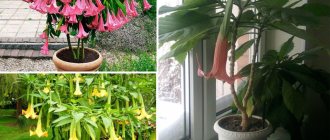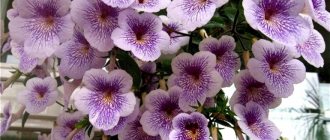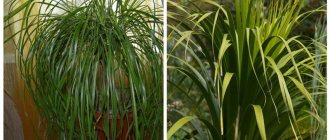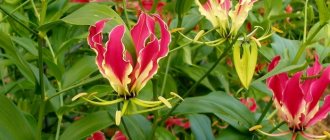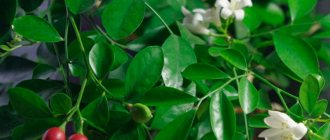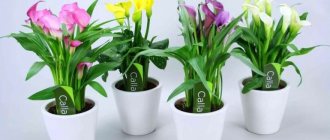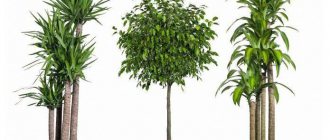In warmer regions, Brugmansia can be used as a garden crop. In most Russian regions it is cultivated as a pot or indoor plant. Brugmansia is native to the tropics and subtropics of South America. There are 7 wild species found there. All modern garden forms and hybrids were developed on their basis.
Be sure to pay attention to the beautiful Beloperone plant.
| Growth rate is average. |
| Basically, it blooms all summer, but if illuminated in the evening, it can bloom until winter. |
| Average difficulty of growing. |
| It is a perennial plant. |
Useful properties and toxicity of Brugmansia
At home, the local population uses Brugmansia as a medicinal plant. Its hallucinogenic properties are widely used for religious rituals. It should be borne in mind that all parts of the plant are highly poisonous. They contain high levels of scopolamine and atropine. The rich aroma of Brugmansia flowers can cause a severe headache.
Humidity and watering
Brugmansia grows well at normal air humidity, but in dry weather or excessive central heating, it is necessary to artificially maintain the humidity at 55-60%.
For Brugmansia, irrigation or installation near a container with water is very important; you can also pour wet sand into the tray - the plant itself will control and absorb moisture from the outside.
In the cool winter period, you should never increase the humidity; such actions will lead to withering of the plant, rotting of the trunk and roots.
The water must be at room temperature, soft, and allowed to stand for several days beforehand.
Brugmansia flower, planting and caring for it at home includes abundant watering, up to 2-3 times a day. The soil should never remain dry or even minimally dry.
It is interesting to know that with the beginning of flowering, the process of pasturing the leaf mass decreases, so watering can be moderated to once a day.
During the winter dormant period, watering is reduced to a minimum, but checking the looseness of the soil and optimal humidity, without drying out. If Brugmansia continues to flower and grow even in winter, the frequency of watering does not change.
Brugmansia: care at home. Briefly
Brugmansia at home requires certain care:
| Temperature | Room temperature in summer, no higher than +15° in winter. |
| Air humidity | Requires a high humidity level of at least 60%. |
| Lighting | Intensive, when placed on the south side with shading. |
| Watering | The substrate must be kept moist at all times. |
| Priming | Light, fertile, always with a drainage layer. |
| Feeding and fertilizer | Requires constant use of fertilizers. |
| Brugmansia transplant | As it grows, sometimes up to 2-3 times a year. |
| Reproduction | Seeds or apical cuttings. |
| Features of cultivation | Requires constant shaping and pruning. |
Fertilizer and pruning
For active and healthy growth of the tree during the season, it is advisable to feed it every week. It is possible to use ready-made multicomponent baits, such as potassium-phosphorus fertilizers. If the volume of the container in which Brugmansia grows is 5 liters, you need to add 1 teaspoon of fertilizer during watering.
You can determine the lack of nutrients by the leaves that have begun to turn yellow and the discarded buds. You can stop intensive feeding at the beginning of autumn.
To give the required shape to the crown and control growth, it is possible to trim the branches of the tree. This should be done in the spring, before the start of the growing season. Also, with the help of pruning, it is possible to stimulate the flowering of the plant; to do this, you need to remove the shoots that have grown at the base of the trunk.
Brugmansia: care at home. Details
Caring for Brugmansia at home requires some experience. The plant is very demanding regarding wintering conditions and watering regime.
Brugmansia flowering
Brugmansia flowers are shaped like long gramophones.
Depending on the species, they can be pink, white or yellow. They do not last long on the plant, but this more than covers the abundance of flowering. The flowering period lasts all summer. With additional lighting, Brugmansia can bloom in winter.
Temperature
Brugmansia at home develops best at temperatures from +23 to +25°. During the summer heat, the room must be ventilated as often as possible. If possible, it is best to take the flower pot out into the garden. Changes between day and night temperatures will only benefit the plant.
In winter, Brugmansia is kept at +10-15°. When such conditions are created, a period of rest begins. If there is no opportunity to reduce the temperature, the plant must be illuminated.
Spraying
Homemade Brugmansia requires constant spraying, sometimes several times a day. The air humidity level should not fall below 60%. The water must be warm and soft.
Lighting
The Brugmansia plant at home requires constant intense lighting. South oriented windows are best suited for her. On the north side it needs to be illuminated almost constantly. The lighting can be arranged using fluorescent lamps or special phyto lamps with a pink spectrum.
Watering Brugmansia
Brugmansia needs plenty of watering. During periods of intensive growth, it has to be watered up to 2 times a day.
The soil in the pot should never dry out. As flowering begins, leaf growth decreases, so watering can be reduced somewhat. In winter, when dormancy sets in, it is reduced to a minimum. In this case, the substrate should not be allowed to dry out completely. If the plant continues to grow actively in winter, keep the same intensity of watering.
Pot for Brugmansia
Brugmansia intensively grows its root system, so the pot for it should be wide and deep. And even despite this, it has to be carefully transshipped several times a year.
Priming
The soil for growing Brugmansia is made up of equal parts of well-rotted leaf soil, peat, humus and perlite. 2 parts of turf soil are added to them. You can also use a ready-made universal substrate for growing seedlings.
Feeding and fertilizers.
Brugmansia needs constant fertilization. During the period of intensive growth, it is fed with nitrogen-containing fertilizers. At the moment of bud laying, phosphorus-potassium. In this case, it is recommended to alternate mineral complexes with organic matter. On average, fertilizers are applied once a week. In winter, during the dormant period, feeding is stopped.
Transfer
Brugmansia is transplanted as it grows.
As soon as the roots have mastered the entire volume of the pot, the plant is immediately transferred to a larger container. On average, at least 3-4 transshipments are required per year. When replanting, proceed with caution; Brugmansia roots are quite fragile. To quickly restore the root system, it is recommended to use Kornevin.
How to prune Brugmansia?
The rapidly growing Brugmansia needs to be constantly shaped. In spring, all its shoots are shortened by about a third. It is very important to observe moderation. Too much pruning will significantly reduce the abundance of flowering. Since flower buds are already laid on the branches. During the summer, some of the shoots are periodically removed from the bushes. A large number of shoots reduces the number of flowers.
Brugmansia on the street, can it be taken out onto the balcony?
In the summer, Brugmansia can be taken out into the garden or onto the balcony. It is placed in well-lit places. She does not require additional sun protection. To reduce the number of waterings, the pot with the plant can be dug into the soil. The natural difference between day and night temperatures of Brugmansia is only beneficial. In such conditions, it lays a large number of flower buds. Before the onset of severe cold, the plant is brought into the house.
Wintering Brugmansia at home
To overwinter Brugmansia, you need a bright room with a temperature no higher than +10°. It is kept almost dry at high air humidity. If there is no glazed balcony or special room, the pot is placed on a bright, cool window.
To create high humidity, the plant is constantly sprayed. In such conditions, Brugmansia overwinters without any problems, in some cases it even continues to bloom. During a warmer winter, it may shed all its leaves or even die.
Reproduction methods
Botanical varieties of Brugmansia can be propagated by cuttings or sowing seeds. Selected varieties can only be propagated by cuttings.
Cuttings
You can propagate Brugmansia yourself by cutting cuttings.
How to root Brugmansia cuttings:
- Cut fragments of the shoot apex 20 cm long, with three apical leaves, paying attention to the fact that the seedlings have a slightly woody base.
- The bases of the cuttings are immersed in a rooting agent.
- They are then placed in a damp mixture of sand and peat or water.
- The container is covered with colorless perforated film.
- Place them in a bright but not sunny place at room temperature. After 3-4 weeks, the first roots should appear.
The procedure can be carried out from spring to autumn. After a month, the rooted cuttings are transplanted into a pot filled with fertile humus substrate. After the cuttings reach about 30 cm in height, it is worth trimming the top so that the plant bushes beautifully.
Seeds
Brugmansia is sown from seeds in early spring - from January to March.
Seedlings may begin to bloom in the second year. The germination efficiency of seeds is 70-80% - it is important to prepare them correctly to increase the likelihood of obtaining healthy, strong seedlings.
Seed preparation
Preparing seeds for sowing takes place in 3 stages:
- Treatment for diseases. Disinfection of seeds with fungicides.
- Soaking - to speed up germination, seeds are immersed in warm water for 24-48 hours.
- Scarification of seeds - with a sharp instrument, such as a razor blade, the outer layer of the seed coat is damaged, which facilitates germination.
Preparing the soil for sowing
Ready-made soil mixtures available at garden centers can be used to sow seeds. Brugmansia prefers permeable, light soils, so it is worth adding sand or perlite to the finished mixture. The quality of the soil can be improved by adding humus and compost. The substrate blank can be disinfected in the oven to disinfect it.
Brugmansia seeds germinate better when they are provided with greenhouse conditions - high temperature and humidity. Therefore, the container intended for sowing must be covered, for example, with a glass lid or film, transparent plexiglass. You can poke a few small holes in the lid of the container or ventilate it regularly to avoid excessive condensation.
Sowing seeds
- Add some drainage and fertile soil to the bottom of the pot. There should be drainage holes at the bottom.
- The prepared substrate is slightly moistened.
- Carefully spread the seeds over the surface of the soil after 3 cm and press lightly. The seeds are covered with a small layer of substrate about 5 cm.
- Place the container on a windowsill or other warm, bright place in the apartment, where the minimum temperature is 22-25 degrees C.
- The container should be ventilated several times a day by opening the lid. If condensed water vapor accumulates on the surface of the lid, remove it with a paper towel.
- We check the soil moisture level daily and moisten the surface if necessary.
Growing seedlings
- The first shoots should appear within 2 weeks, but germination may take longer. We water the seedlings.
- When the seedlings have about 5-6 true leaves, they are transplanted into separate pots with fertile, well-drained soil.
- 2 weeks after transplanting into separate pots, you can begin to feed the seedlings with small doses of fertilizer.
- Young seedlings can be planted outside in the second half of May, when the danger of frost has passed. Before planting, seedlings need to be hardened off daily for 2 weeks and taken outside, exposed to the sun for an increasingly longer period of time.
Growing Brugmansia from seeds
Brugmansia can be propagated by sowing seeds. It should be borne in mind that varietal characteristics will only be partially preserved. For sowing, prepare a light, moisture-intensive substrate from equal parts of peat, sand and perlite. The seeds are planted to a depth of no more than 1 cm. To create increased humidity, the container is covered with a piece of glass or film.
As soon as the first shoots appear, they are immediately removed. After the development of 3-4 true leaves, the seedlings are transplanted into separate containers. The main disadvantage of seed propagation is the long cultivation time. It takes 2-3 years from sowing to flowering.
Growing using cuttings
To propagate Brugmansia, you can use stem cuttings, which are best cut in May.
Young shoots with 3-4 internodes are ideal, with the lower foliage cut off and the upper foliage left in half. The resulting cuttings must be dipped in rooting hormone and only then immersed in a peat-perlite mixture to a depth of 3 centimeters.
It is advisable to cover the cuttings with a transparent bag and leave them in a well-lit place. You should not overdo it with watering, but the soil should be moist enough. Rooting of cuttings occurs on average after a month. The first flowering of a new plant occurs after 1-2 years
Diseases and pests
When growing Brugmansia, flower growers face a number of problems:
- Brugmansia does not bloom. The problem occurs when there is an excess of nitrogen in the soil or when there is insufficient lighting.
- Shoots stretch out. Most likely the plant suffers from lack of light.
- The young leaves of Brugmansia turn yellow and fall off. The reason may lie in too much nitrogen fertilizer.
- Brugmansia is rotting. Excessive watering and heavy soil lead to the development of root rot.
- Brugmansia leaves fall in winter. The flower does not have enough light.
- Leaves are falling. The plant was very dry.
The most common pests on Brugmansia are spider mites and whiteflies.
Brugmansia in landscape design, combination with other plants
The bushes look great against the backdrop of carpet flower beds and flower lawns. The stunning view is formed against the backdrop of plain hedges. You can plant the trees in pre-prepared barrels, place the containers at the front entrance of the site or along the perimeter of the gazebo.
The shrub looks nice next to other representatives of flower crops. For example, you can plant hibiscus nearby. Dahlias and roses will also become worthy neighbors of Brugmansia.
Types of Brugmansia with photos and names
The following types are used in indoor floriculture:
Brugmansia sanguinea
A distinctive feature of the species are orange-red flowers with yellow veins, which have absolutely no aroma. At prolonged temperatures above +25°, the plant refuses to bloom. Under natural conditions, the species is distributed in Chile and Ecuador.
Brugmansia snow-white Brugmansia candida
The flowers are tubular in shape and have a strong scent in the evening. Their color, depending on the variety, can be white, pink or yellow. The leaves are oval-shaped, slightly pubescent, on long petioles. The species lays buds only after differences between day and night temperatures.
Brugmansia suaveolens
The species is native to eastern Brazil. In nature it grows as trees up to 5 meters high. Flowers are white or pink, up to 30 cm long.
Golden Brugmansia (Brugmansia aurea)
Tall, large plants with yellow flowers. The flowers have a characteristic outward bend. The species is native to northern Colombia.
general information
Brugmansia belongs to the nightshade family, and now it is officially the only representative of its genus. This is a large tree-like plant from South America with huge bell-shaped flowers.
Brugmansia can grow in open ground only in some areas in the South and the Caucasus. In most cases, it is safely grown in tubs, and even so it grows up to 2 m. But keep in mind that its parts contain intoxicating substances!
Brugmansia has a complex and powerful root system, which in natural conditions goes several meters deep. Large tubular flowers grow up to 25 cm in length and up to 15 cm in diameter. They smell strong, and the aroma intensifies in the evening. Flowering lasts in waves from mid-summer.
Photo: mydesiredhome.com
Rhododendron
Truly a gorgeous plant! It transforms into a bush, a tree, and even penetrates into houses under the guise of an indoor flower. But it carries with it andromedotoxin, which is the culprit of nausea, pain, and even death when ingested.
Very poisonous, but so amazing!
Description of the plant
Brugmansia is a climbing plant with long stems arranged alternately.
The leaves have a green tint, an oblong shape, and in some varieties the foliage is jagged along the edges. They can reach 30 cm in length.
In summer, buds form on the branches. During the flowering period, they bloom, resulting in flowers of white, pinkish, and yellow colors.
They have a tubular appearance, are quite long, and emit a strong aroma that literally fills the room.
The aroma of Brugmansia is strong and persistent
Cerberus or “suicide tree”
It is a great blessing that this tree does not grow in our area. But residents of South Asia and India are out of luck, as Cerberus is very dangerous. It is often used by people who want to end this life. The glycoside cerberine contained in the plant causes severe pain in the abdomen, then coma and cardiac arrest.
Some varieties of Brugmansia
Delicate yellow Brugmansia Hazelnut Buttercup with double crowns resembles fluffy whipped cream on a cake.
The original Brugmansia variety, Audrey Lea, is much brighter than many other varieties. Its double corollas are painted in delicate coral tones, and the fused petals are intricately curled.
The variegated Brugmansia Snowbank with white or cream-colored flowers is a plant for those who are not used to half measures. Everything is great here! And large flowers of a simple shape, and oval-pointed leaves with a white-yellow border and silvery spots on a green background.
With its rich orange-yellow hue, Brugmansia Langenbuscher Garten flowers not only attract pollinating insects, but also attract the attention of those around them. This is a luxurious decoration for a garden or a spacious greenhouse.
The bright citrus variety of Brugmansia Zitronenprinzessin was obtained by German breeders and fascinates not only with the joyful color of the corolla, but also with its two-layered shape.
The splendor and lightness of the white corolla is difficult to argue with the Brugmansia variety Adretta. The peculiarity of the plant is a long greenish flower tube and a triple layer of petals.
